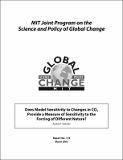Does Model Sensitivity to Changes in CO2 Provide a Measure of Sensitivity to the Forcing of Different Nature?
Author(s)
Sokolov, Andrei P.
DownloadMITJPSPGC_Rpt119.pdf (270.2Kb)
Metadata
Show full item recordAbstract
Simulation of both the climate of the 20th century and of possible future climate change requires taking into account numerous forcings of different nature. Climate sensitivities of existing general circulation models, defined as the equilibrium surface warming due to increase in atmospheric CO2 concentrations, vary over a rather wide range. A large number of simulations with the MIT climate model of intermediate complexity with forcings of different nature have been carried out to study to what extent sensitivity to changes in CO2 concentration represent sensitivities to other forcings. Sensitivity of the MIT model can be changed by changing the strength of the cloud feedback.
Simulations with the versions of the model with different sensitivities show that the sensitivity to changes in CO2 concentration provides a reasonably good measure of the model sensitivity to other forcings with similar vertical stratifications. However the range of models’ responses to the forcings leading to the cooling of the surface is narrower than the range of models’ responses to the forcings leading to warming. This is explained by the cloud feedback being less efficient in the case of increasing sea ice extent and snow cover. The range of models’ responses to the forcings with different vertical structure, such as increase in black carbon concentration, is also smaller than that for changes in CO2 concentration.
Description
Abstract in HTML and technical report in PDF available on the Massachusetts Institute of Technology Joint Program on the Science and Policy of Global Change website (http://mit.edu/globalchange/www/).
Date issued
2005-03Publisher
MIT Joint Program on the Science and Policy of Global Change
Citation
Report no. 119
Series/Report no.
;Report no. 119